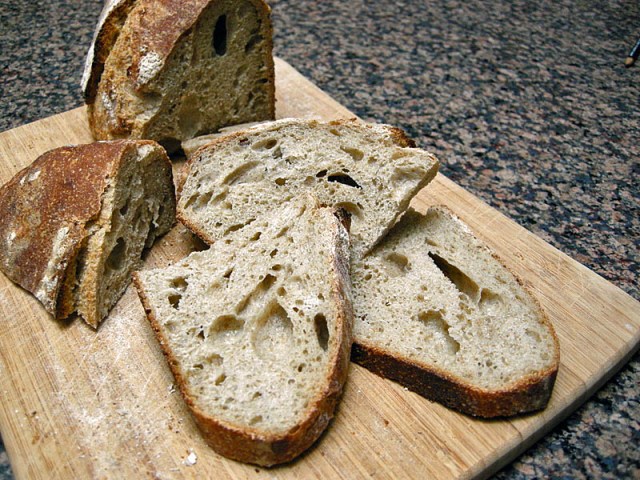We spent last week in Oklahoma, which gave me the opportunity to bake bread in a normal oven. After some severe brainstorming over the recipe, I settled on a country rye from Tartine, one of my favorite bread books. It calls for a sourdough starter with a 50:50 mixture of white and whole wheat flours, and the dough itself has a small amount of rye. Usually I’d retard the loaf overnight in the fridge (as recommended), but this time I baked it just 3 hours after the final shaping. The oven rise was impressive, the bread almost exploded out of the slashes! It’s a vision that makes me so happy… 😉
COUNTRY RYE
(adapted from Tartine)
For the leaven (8 hours before making the dough):
1 Tbs sourdough starter, very active
140ml water
70g white bread flour
70g whole wheat flour
For the dough:
100g of leaven (save the rest)
400ml water at 75 F
415g bread flour
85g rye flour
10g salt
Pour the water in a large bowl, add the leaven (only 100g of it) and mix to dissolve. Add the two different flours, mix with your hands to form a shaggy mass. Cover and let it sit at room temperature for 40 minutes. Sprinkle the salt on top of the dough and knead to mix it.
Let the dough go through a bulk rise of 3 hours, folding the dough at every 30 minutes. Pre-shape the dough as a ball, let it rest undisturbed for 20 minutes, then shape it in its final round shape, place it in a round container with the seam up for 3 hours (you can also retard the dough in the fridge for 12 to 16 hours).
Bake for 45 minutes in a 450 F oven, with steam during the first 25 minutes. Allow it to completely cool before slicing.
ENJOY!
to print the recipe, click here
Comments: For the first time I baked this type of bread without weighing the ingredients, because my balance stayed in the nano-kitchen. I was a bit nervous, but I used a conversion table and it worked just fine. The more I bake with wild yeast, the more convinced I am that technique trumps the proportions of ingredients. For example, folding the dough enough times during fermentation, and creating proper surface tension in the final shaping have a huge impact on the final product. My advice is to practice, practice, and practice some more. I still struggle with scoring the bread, never feeling confident with the razor blade in my hand. What bothers me is that the scoring is so… final! Once you slash the surface, you can only hope you did it right. 😉
The crumb was a little less open than that of a bread exclusively made from white flour, and the taste reminded me of a Poilane miche, but less dense. It’s a bread for a ham sandwich, or one with which you can mop up the juices of a hearty pot roast, or perfect to toast and enjoy with a little Brie cheese.

I am submitting this post to Susan’s Yeastspotting event… make sure to stop by and amaze yourself with all the tempting breads.
ONE YEAR AGO: My New Favorite Tomato Sauce





























